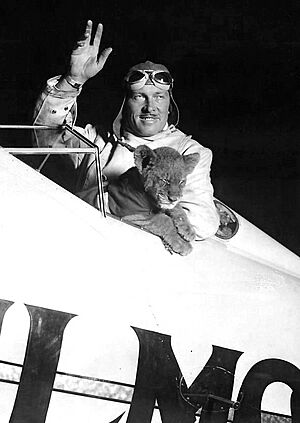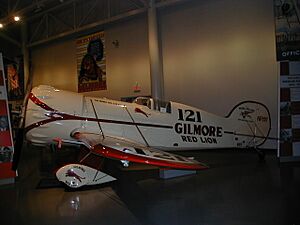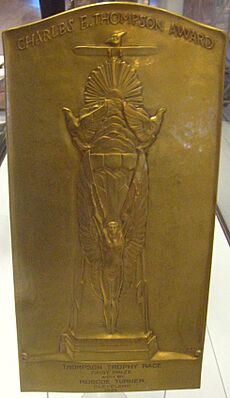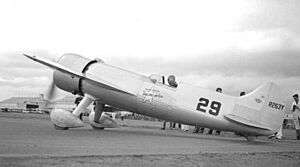Roscoe Turner facts for kids
Quick facts for kids
Roscoe Turner
|
|
|---|---|
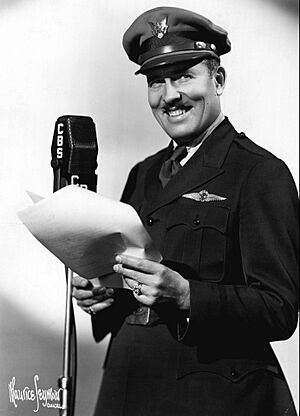
Turner as narrator on the "Sky Blazers"
|
|
| Born | September 29, 1895 Corinth, Mississippi, U.S.
|
| Died | June 23, 1970 (aged 74) Indianapolis, Indiana, U.S.
|
| Nationality | American |
| Known for | Flight at Midnight |
| Spouse(s) |
Carline Stovall
(m. 1924–1946)Margaret Madonna Miller
(m. 1946) |
| Awards |
|
| Aviation career | |
| Famous flights | Transcontinental airspeed record New York to Los Angeles (1930, 1932); Transcontinental airspeed record Los Angeles to New York (1933); MacRobertson Air Race (1934); Bendix Trophy (1933); Thompson Trophy (1934, 1938, 1939) |
| Military service | |
| Allegiance | |
| Service/ |
United States Army |
| Years of service | 1917–1919 |
| Rank | First Lieutenant |
| Battles/wars | World War I |
| Awards | |
Roscoe Turner (September 29, 1895 – June 23, 1970) was an amazing American pilot who broke many flight records. He won the Thompson Trophy air race three times. People knew him for his flashy style and his pet lion, Gilmore.
Contents
Early Life and Dreams of Flight
Roscoe Turner was born in Corinth, Mississippi, in 1895. He was the oldest son of a farmer. From a young age, Roscoe loved fixing and building things. He worked on wagons, motorcycles, and cars.
He didn't want to be a farmer. He dreamed of working with machines, especially on the railroad. Later, he moved to Memphis, Tennessee, hoping to become a car mechanic. He worked hard and learned to drive trucks.
Roscoe first saw an airplane in 1913. By 1916, he decided he wanted to fly. He tried to join the Army for flight training. Even though he was good with machines, he didn't have a college degree, which was required then.
Serving in World War I
When America joined World War I in 1917, Roscoe joined the Army. He started as an ambulance driver. Soon, he became a sergeant. In 1918, he was accepted to train as a balloon pilot.
He became a second lieutenant in the Signal Corps. Later, he went to France and Germany. There, he got some unofficial training flying airplanes. He returned to the U.S. as a First Lieutenant in 1919.
Barnstorming Adventures
After the war, Roscoe became a "barnstormer." This meant he flew planes around the country. He gave rides to people and performed daring stunts. He even staged fake plane crashes for shows!
Roscoe wore a special uniform he designed himself. It was blue with fancy pants and boots. He said his unique look helped his business. He also grew a waxed mustache.
In 1922, Roscoe faced a legal issue related to an aircraft purchase. He was later granted a full pardon by President Calvin Coolidge in 1924. He then returned to flying and started the Roscoe Turner Flying Circus.
In 1924, Roscoe married Carline Hunter Stovall. They got married in his airplane, with the minister standing nearby! This event brought a lot of publicity.
Flying for Hollywood and Airlines
In 1925, Roscoe got a large, twin-engine plane called the Sikorsky S-29-A. He used it for charter flights and publicity stunts. In 1928, he flew this plane to California.
The famous movie director Howard Hughes leased the plane for his movie Hell's Angels (1930). Roscoe often piloted the plane in the movie. Sadly, the plane crashed during a stunt, and one person died.
Around this time, Roscoe and his wife became part of Hollywood society. He also worked on experiments to safely recover entire aircraft using parachutes. In 1929, he became the chief pilot for Nevada Airlines. He flew planes like the Lockheed Vega between cities like Los Angeles and Las Vegas. People used these flights for gambling and quick marriages or divorces in Nevada.
Exciting Air Races
Roscoe Turner started air racing in 1928. He raced a Timm Aircoach and later a Lockheed Vega. In 1929, he tried to break the transcontinental airspeed record. He didn't break it then, but it made him famous.
Later, the governors of Nevada and California made him a military aide de camp. He was given the rank of lieutenant colonel. From then on, Roscoe was known as "Colonel" Turner.
In 1930, Roscoe got a Lockheed Air Express plane. It was painted cream with red and gold, and had a lion's head logo. This was to advertise Gilmore Red Lion products for the Gilmore Oil Company.
Roscoe found a lion cub for sale. He convinced the owner to give it to him in exchange for promoting his lion farm. Roscoe named the cub 'Gilmore'. He raised Gilmore at his home and even took him on flights! Gilmore had his own special parachute. Gilmore flew with Roscoe until about 1935, when he got too big. Gilmore lived until 1952. His body was preserved and is now displayed at the Smithsonian Institution.
On May 27, 1930, Roscoe flew his Air Express from New York to Los Angeles. He broke the east-west transcontinental airspeed record.
In 1931, Roscoe was impressed by Jimmy Wedell's fast plane, the Wedell-Williams Model 44. He got money from Gilmore Oil Company to have Wedell build him a new, faster version.
At the 1932 National Air Races, Roscoe came third in the Bendix Trophy race. On November 14, 1932, he flew his Model 44 from New York to Burbank. He broke the east-west transcontinental airspeed record again!
In 1933, Roscoe won the Bendix Trophy race. He flew from New York to Los Angeles in just 11 hours and 30 minutes. This broke his own record! He then upgraded his Model 44 with an even more powerful engine. On September 2, 1933, he flew from Los Angeles to New York in 10 hours and 4 minutes. This broke the west-east transcontinental airspeed record.
At the 1934 National Air Races, Roscoe won the Thompson Trophy. This was a big victory for him.
The MacRobertson Air Race
In 1933, Roscoe heard about the MacRobertson Air Race. This was a huge race from London, England, to Melbourne, Australia, in October 1934. He got sponsors like Boeing and United Airlines. United Airlines even lent him one of their newest airliners, a Boeing 247.
Roscoe chose Clyde Pangborn as his co-pilot. Clyde had lots of experience with international flights. They also had Reeder Nichols to operate the radio.
Roscoe's team left England on October 20. The race was 11,300 miles long! They had some adventures, like almost running out of fuel in India. They made several stops along the way.
They finished the race in Melbourne in 92 hours and 55 minutes. They came in third place overall. The Boeing 247 they flew is now displayed at the National Air and Space Museum.
More Air Racing Triumphs
In 1935, Roscoe continued to promote many products. He entered the Bendix Trophy race again. He finished just seconds behind the winner.
In 1936, Roscoe was flying his Wedell-Williams Model 44 when it had engine problems near Flagstaff, Arizona. He had to crash-land. He broke some ribs and a bone in his neck. He then traveled many miles to get medical help.
Roscoe then worked on designing a new racing plane. It was called the 'Turner Special' (officially Turner-Laird RT-14 Meteor). He wanted it to be fast for both cross-country and circuit races.
In 1938, Roscoe won the Thompson Trophy race with his 'Pesco Special' (the Turner Special). He flew at an amazing average speed of 283.4 miles per hour!
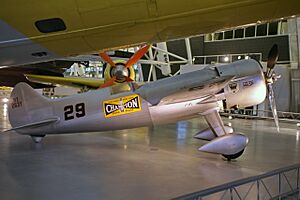
In 1939, Roscoe won the Thompson Trophy again! This was his third win. After this race, he announced, "This is my last race. I'll be 44 this month. This is a young man's game." He decided to retire from racing.
Radio and Movies
In 1939, Roscoe hosted a radio show for kids called Sky Blazers. It was sponsored by Wonder Bread. The show told exciting stories about brave pilots.
That same year, he played himself in the movie Flight at Midnight. In the film, he helps a stunt pilot save an airfield from closing.
Business and Later Life
In 1939, Roscoe started his own aviation company, the Roscoe Turner Aeronautical Corporation (RTAC). It offered plane sales, repairs, and flight training. During World War II, RTAC trained many pilots.
In 1948, RTAC got permission to start an airline called Turner Airlines. However, Roscoe couldn't get enough money for it. He sold the idea, and it later became Lake Central Airlines.
In 1949, a special act of Congress awarded Roscoe the Distinguished Flying Cross. This is a very high honor for bravery in flight. He was the last civilian to receive this award.
In 1961, a new Roscoe Turner Airport was opened in Corinth, Mississippi, named after him. Roscoe Turner passed away on June 23, 1970. He is buried in Crown Hill Cemetery in Indianapolis.
Military Awards
Roscoe Turner received several military awards, including:
Legacy and Recognition
Roscoe Turner's pet lion, Gilmore, is now part of the collections at the National Air and Space Museum. Many of Roscoe's trophies and other items are there too.
The Roscoe Turner Airport in Corinth, Mississippi, is named in his honor. There's also an exhibit about his life at the Crossroads Museum in Corinth.
In 1975, Roscoe Turner was honored in the National Aviation Hall of Fame. His famous racing plane, the Turner RT-14 Meteor, is on display at the National Air and Space Museum's Udvar-Hazy Center. It was moved to the main museum in Washington, D.C., in 2022.
See also
- List of covers of Time magazine (1930s)
- List of members of the American Legion
- The Adventures of Smilin' Jack


